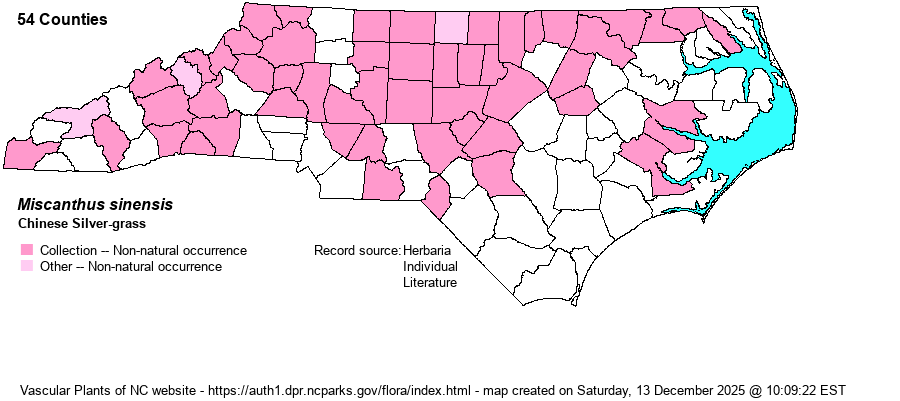| Author | Andersson | |
| Distribution | Mostly Mountains and Piedmont; scattered in the Sandhills and Coastal Plain. Cultivated at Biltmore Estate (Buncombe County) as early as 1898; escaped or adventive as early as 1935 (Moore County) and 1939 (Mason Farm in Orange County).
Native to Southeastern Asia; in N.A. mostly in the East from MA to MO, south to northwestern FL and LA. | |
| Abundance | Uncommon to frequent in the Mountains and Piedmont, rare to uncommon in the Coastal Plain. Appears to be greatly increasing in the Mountains and upper Piedmont -- regions where it is especially troubling. | |
| Habitat | Mostly in moist soils of roadsides, powerlines, wooded slopes, ravines, thickets, outcrops, along streams, margins of impoundments. This aggressive alien grass has become a concern in recent decades, as it invades some natural habitats. Even when not invading natural habitats, it crowds out native herbaceous vegetation of roadbanks and wooded margins, such as numerous species of composites. | |
| Phenology | Flowering and fruiting September-November. | |
| Identification | This grass forms dense clumps 2-4 feet tall of leafy stems. Leaves are long, narrow, taper-tipped and 2-ranked; most are green but some plants are banded with yellow. Inflorescences are raised above the leaves and may reach 5-6.5 feet; they are rather ob-pyramidal, multi-branched, and silvery white with hairs. Usually it can be easily spotted along a roadside or roadbank while you are driving, as the large and bushy "foxtail" inflorescence is conspicuously white against the green vegetation. | |
| Taxonomic Comments | | |
| Other Common Name(s) | Maiden Silver-grass | |
| State Rank | SE | |
| Global Rank | GNR | |
| State Status | | |
| US Status | | |
| USACE-agcp | UPL link |
| USACE-emp | FACU link |

